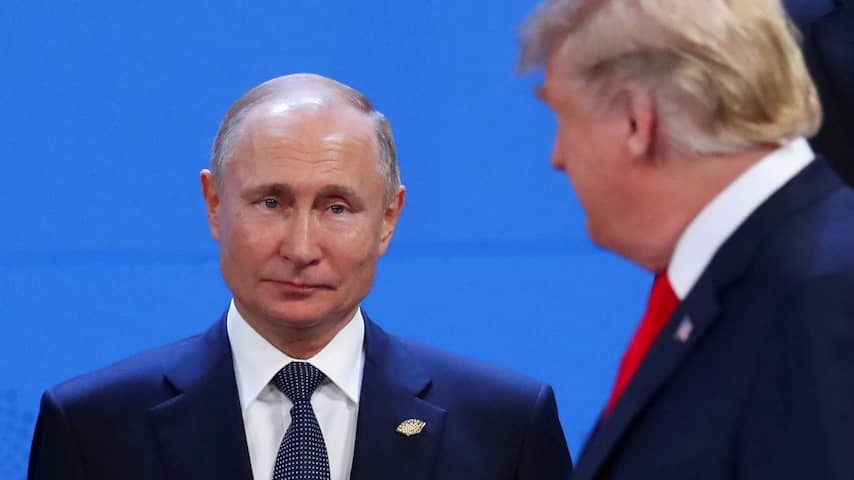
The romantic image exists that Donald Trump suddenly regretted his harsh treatment of Volodymyr Zelensky, his admiration for Vladimir Putin, and his decision to suspend American arms aid to Ukraine.
Perhaps it’s due to a touch of wisdom in the fickle Trump. Perhaps it’s due to the moist eyes of the Ukrainian journalist Myroslava Petsa. She begged Trump during the NATO summit for Patriot missiles, while her husband 2,000 kilometers away fought for his life in the trenches. It could even be due to the “good conversation” he had with Zelensky in the Hague corridors.
The fact is that after a bullshit phone call with Putin on July 3, Trump suddenly changed his mind. Suddenly, he was “disappointed” in Putin and Ukraine would be supported with enormous numbers of weapons. Trump also threatened sanctions for Russia if the war wasn’t resolved within fifty days. Putin will shrug it off. He can fire the necessary drones at Ukraine until September 3, and then see what happens next.
American self-interest also plays a role in Trump’s conversion. In the meantime, quite a few things had happened. There was no coordination between the Pentagon and the White House regarding the suspension of arms support. The excuse that the US itself urgently needed the weapons for its actions in Iran has now been refuted. Indeed, thirty to fifty Patriot missiles were needed to intercept Iranian retaliatory missiles. They had done their job, so now Ukraine could be served again.
War now waged in three ways
Simply put, the war on the edge of Europe is now waged in three ways. The land war isn’t progressing. Putin would like to push through and dreams of conquering half of Ukraine before 2026. But in all of 2025, the Russian territorial gain has been about 14 square kilometers per day. At that pace, it will take years.
The second front is in the air. The Russian missile rain on Ukrainian cities is a terrible advantage for Russia. But it’s also expensive, and therefore finite. The Russian supplies aren’t that large, and it’s make-or-break for the Russian economy.
Only the Patriot missiles offer protection to Ukrainian hospitals and apartment buildings, so those systems must find their way back to Ukraine. Trump’s turnaround isn’t compassion, but based on money. Ukrainian victims will be secondary to him as soon as Iran fires missiles again.
The third front is a technological race. Ukraine has become a true testing ground for warfare. You can speak of a revolution on the battlefield, or a wake-up call for sleepy armed forces that stubbornly invest in old-fashioned warfare. According to war experts, Europe and even the US can still learn a lot from Ukraine. Trump’s turnaround might also have to do with that.
Three operations turn military science upside down
In recent weeks, three operations have given analysts many new insights. First, Ukraine destroyed eleven (some say dozens) of Russian bombers with Operation Spiderweb. That happened with drones that struck thousands of kilometers deep into Russia.
Ukraine proved that you can disable expensive weapons systems of an enemy with dirt-cheap, smuggled drones. The drones cost 600 to 1,000 dollars apiece, the Russian bombers that were disabled 270 million dollars. Operation Spiderweb is estimated to have cost Ukraine a total of ‘only’ 117,000 dollars, not even a tenth of a single Kh-101 missile that hangs on such a Russian Tupolev.
On June 13, Israel unleashed Operation Rising Lion, a twelve-day punishment of Iran. Here too, there were smuggled drones, but they were now smuggled into the enemy country. The Iranian air defense was destroyed with them, after which ‘old-fashioned’ Israeli fighter planes had free rein for days.
That brings us to June 22. Then American bombers dropped the heaviest bombs in the world on the Iranian uranium facility in Fordow. Code name: Midnight Hammer. With bunker busters, an unwanted nuclear program was bombed back a few years in time, while the retaliatory blow was easily absorbed.
But the price is high: an Iranian nuclear bomb has been delayed, but not definitively erased. In addition, international law was set aside, diplomacy is temporarily impossible, and both the US and Israel have lost a lot of political credit because they chose violence over tact.
Europe and US can still learn a lot
In a month’s time, we have definitively entered the era of violence and drones. Drones are already being called precision mass destruction weapons. Almost 25,000 drones are said to have been fired at Ukraine this year, a tenfold increase compared to last year. Ukraine uses every possible means to intercept them, up to Dutch fishing nets that are hung above important intersections. Yet 70 percent of the victims in Ukraine now fall due to drones.
The events in Ukraine and Iran have shown that major powers are vulnerable, and that even the US (and Europe) can learn a lot from a country like Ukraine. John Finer and David Shimer, two top figures from the previous National Security Council, went on a ‘study trip’ to Ukraine on behalf of the US. When they returned, they urgently advised their government to work with Kyiv and invest mountains of money in it directly. The resumption of arms aid such as Patriots serves as a remedy.
The US is now second in some areas. A major turnaround is needed in the country, where billions are now being invested in expensive planes and naval ships. Ukraine now makes a million drones a year that cost 600 dollars apiece. The Americans should learn from that.
At a lower level, the American army is already starting to get that a bit. Experiments are being carried out by taking 3D printers with them instead of the drones themselves. That saves space and money. In this way, self-interest becomes all the more clear as the underlying reason for Trump’s turnaround.